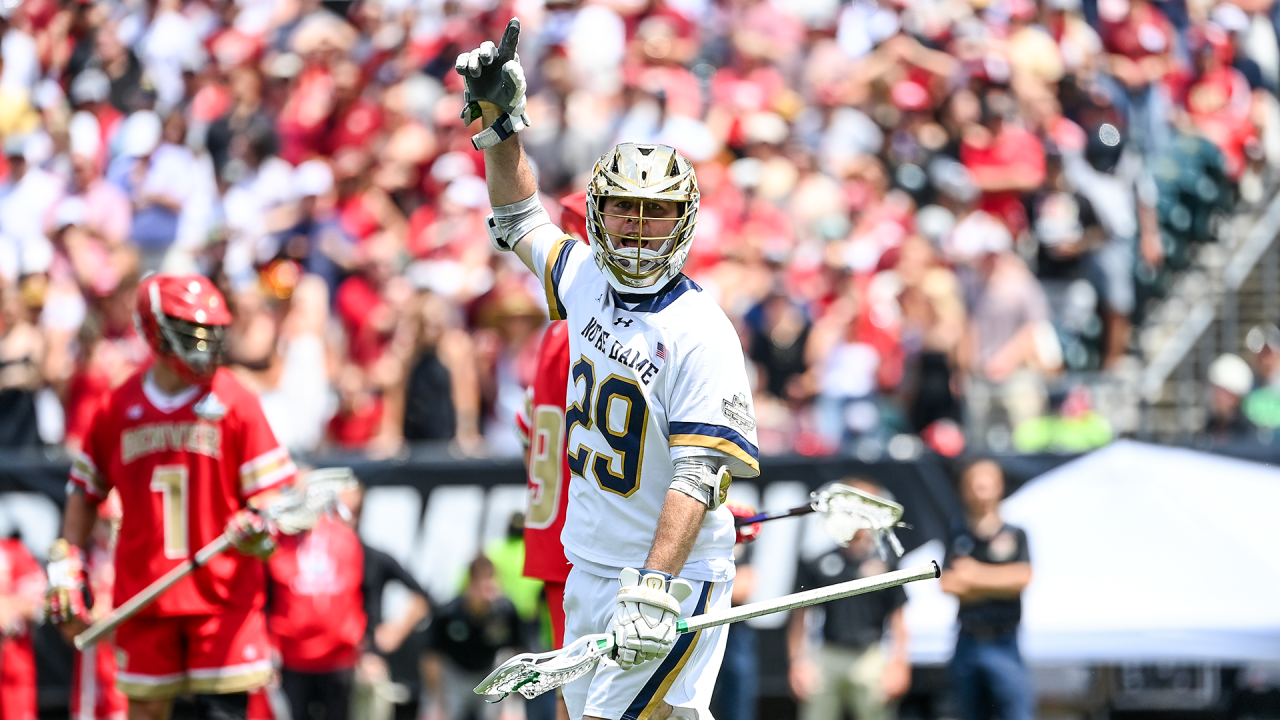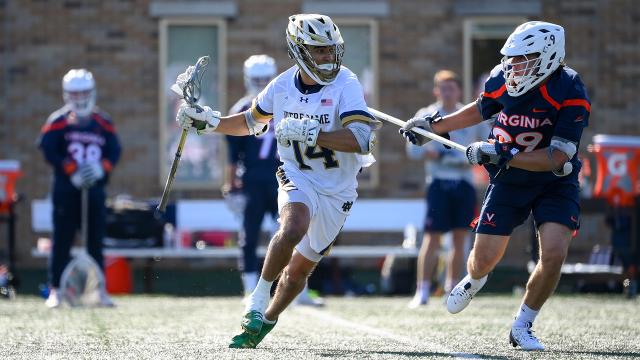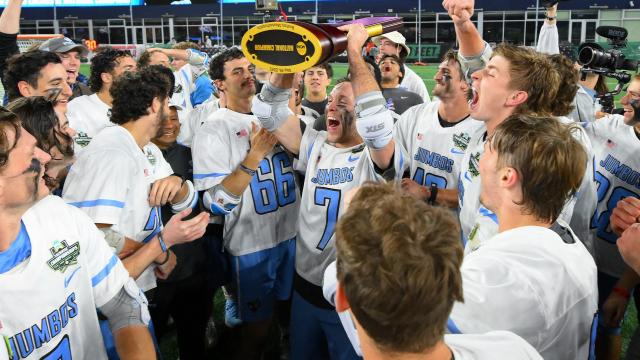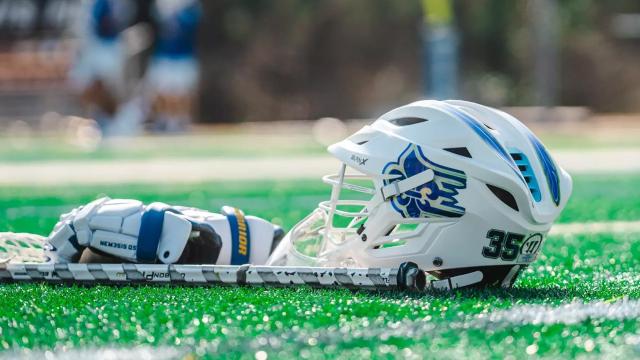
Midfield Depth, Dueling Faceoff Aces Set Stage for Memorial Day
PHILADELPHIA — Of Notre Dame’s many assets this season — arguably the best goalie in the country, an ace faceoff man, an abundance of Kavanaghs and a cohesive defense — its most distinguishing might be its midfield depth.
And there might not be a better time to have it than Memorial Day.
The top-seeded Fighting Irish (15-1) will seek their second consecutive national title when they meet seventh-seeded Maryland (11-5) on Monday at Lincoln Financial Field. The quick turnaround to the final weekend of the season.
It’s also only the second time all year Notre Dame will play twice in three days. Maryland hasn’t done it since last year’s Big Ten tournament. And with the Irish content to roll out three midfield lines, it’s a distinct advantage.
“It’s awesome to be able to get nine midfielders into a game, and I don’t think you see that across really any team in college lacrosse,” said graduate student Devon McLane, a first-line midfielder. “That means when we’re all going in, you’re fresh, you’re ready to go.”
McLane (36 goals, eight assists), Jordan Faison (21 goals, eight assists) and Eric Dobson (16 goals, 13 assists) would be an imposing enough group on their own. But then the second line of Max Busenkell (10 goals, six assists), Reilly Gray (12 goals, three assists) and Will Angrick (seven goals, five assists) rolls out.
The third group of Bryce Walker (five goals, two assists), Jalen Seymour (three goals, two assists) and Fisher Finley (one goal, one assist) has made an appearance less than 10 minutes into defeats of Georgetown in the quarterfinals and Denver in Saturday’s semifinals.
All three members of the second line had a point against Georgetown. In the semis, Angrick assisted on a goal less than five minutes into the game and Walker fed Jake Taylor for the goal that put Notre Dame ahead for good in the second quarter.
“It’s great to have two good midfields; to have a third is huge,” Maryland coach John Tillman said. “It’s not just this weekend. It’s throughout the year. Every game, you’re getting more people involved and you’re creating that depth. You also realize there might be some games where that third group could be your second group.”
It means just one more thing to get ready for at a point in the season when there isn’t much time to prepare. One edge both teams share is a familiarity with the late May schedule crunch, Notre Dame having done it last year heading into a national title game defeat of Duke, while Maryland has players who were part of its 2021 national finalist and 2022 undefeated championship team.
While the Terps haven’t enjoyed the consistency of the Irish, who enter on a 13-game winning streak, they have saved their best work for the last three weekends.
Maryland has received standout efforts from all over the field, from a crisp offense in the first round against Princeton to Luke Wierman’s exceptional faceoff work to an on-point defensive effort while doubling up Virginia 12-6 on Saturday.
“Even though it’s been bumpy, in a lot of ways these are years where you’re even more proud of the guys,” Tillman said. “You appreciate it more because it just wasn’t easy.”
It’s landed the Terps in their eighth NCAA final in the last 13 tournaments, and they’ll face a No. 1 seed for the first time since falling to Loyola 9-3 in the 2012 title game.
“We understand the animal and beast we’re going up against in Notre Dame,” senior defensive midfielder Nick Redd said. “They’re a phenomenal team. They’ve had a great season. We know we have to be dialed in even more than we were on Saturday.”
One common trait among the finalists — besides Memorial Day experience — is exceptional faceoff play. Wierman has won 71.4 percent of his postseason draws (55 of 77), boosting his faceoff percentage on the season to .624. That’s good for third in Division I, with Notre Dame’s Will Lynch (.636) at No. 1.
Lynch has been even better of late, winning 76 percent (57 of 75) over the Irish’s first three postseason games.
The matchup of two of the best faceoff units in the country means one of two things will happen: A team accustomed to having the ball plenty will be on the other end of things, or both teams will have to deal with relatively even possession.
The latter is how things played out in Notre Dame’s 14-9 defeat of the Terps on March 3. Both teams won 13 faceoffs, with Wierman going 12 of 25 while Lynch was 12 of 18.
“We’ve had the luxury of a lot more possessions than our opponent, so that allows you to overcome maybe some turnovers and some mistakes,” Tillman said. “It doesn’t mean you have to be perfect, but you definitely have to be efficient and make the most of your opportunities. Eventually, over the course of a year, you can’t expect your faceoff guy to be at that clip. It’s hard to do, especially in the playoffs and against a guy like Lynch.”
It’s also difficult to make it to the last day of the season. It was more tumultuous for Maryland, which is looking to join 2011 Virginia (13-5), 2013 Duke (16-5) and 2016 North Carolina (12-6) as the only teams with at least five losses to win a national title with at least five losses.
(Not coincidentally, those are the only three teams seeded lower than fifth to partake in a Memorial Day dogpile; 2011 Virginia and 2013 Duke were No. 7 seeds, while 2016 North Carolina was unseeded).
As for Notre Dame, it can join 2008-09 Syracuse and 2013-14 Duke as the only teams in the last quarter-century to win titles in consecutive years — though the Irish are viewing Monday with a more limited scope.
“It doesn’t really matter what’s happened in our season or their season leading up to this point,” Notre Dame defenseman Marco Napolitano said. “We just have one game versus Maryland tomorrow.”
Patrick Stevens
Patrick Stevens has covered college sports for 25 years. His work also appears in The Washington Post, Blue Ribbon College Basketball Yearbook and other outlets. He's provided coverage of Division I men's lacrosse to USA Lacrosse Magazine since 2010.

Related Articles






